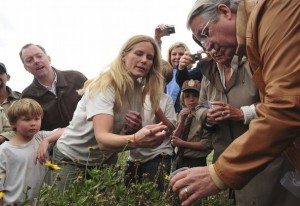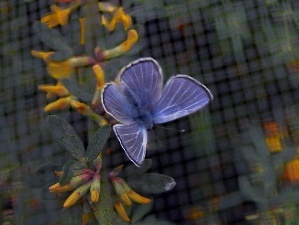
They were thought to have been extinct since the 1980’s but the thumbnail sized Palos Verdes Blue Butterfly (also known as the El Segundo Blue Butterfly) are being brought back from the verge of extinction by the scientists from Moorpark College and a few natural phermones.
The federally endangered Palos Verdes Blue Butterfly (Glaucopsyche lygdamus palosverdesensis) survives only on a few small habitats on the Palos Verdes Peninsula. After a year of presumed extinction, Dr. Rudi Mattoni and colleagues discovered a small population at the Defense Fuel Support Point in San Pedro in 1994. Shortly thereafter, Dr. Mattoni organized a campaign to breed the butterflies, restore their natural habitat, monitor the species growth and reintroduce the species at the PVPLC Chandler Preserve. First administered by the UCLA Department of Geography and then the Palos Verdes Peninsula Land Conservancy in 2002, The Urban Wildlands Group has conducted the captive rearing program, first under Dr. Mattoni’s direction, now lead by Moorpark College professor Jana Johnson.
After 100 years of nurturing thousands of eggs from just a few female butterflies, Jana Johnson and her team have grown a population of more than 5,000 blue butterflies. “We hand feed each butterfly every single day,” she said.
Now, she is taking these captively bred butterflies and released them back into the wild to once again cover the hillsides just 20 minutes south of Los Angeles. “These butterflies were wiped out by man,” said Moorpark biologist Jana Johnson. “And … humans are going to put them back.”
However challenges are great. These blue butterflies have short life span of only 10 days and finding the right mate can be hard. The scientists are releasing the butterflies in batches to make sure they are faring well in their new habitat. So far, 1,000 of the insects have been released.
“He will start patrolling for the ladies and we put a lot of ladies out there for him,” Johnson said. “And I hope he finds them. We need them to mate – lay eggs. That is the next generation”
Then nature can take its course.
(via CBS)













